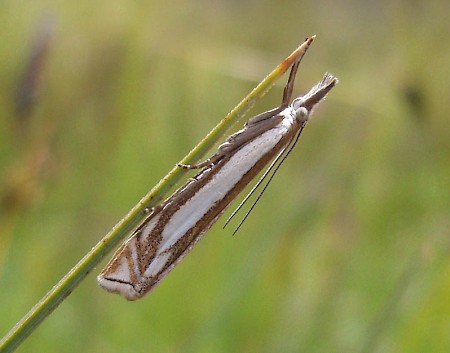63.081 BF1294
Crambus pascuella
(Linnaeus, 1758)
Wingspan 21-26 mm.
Common in most grassy areas of Britain, this species has a distinct whitish streak against a yellow-brown ground colour. This pattern is similar to several other species, and they can be rather difficult to separate.
Flying from June to August, the adults are on the wing at night, when they are attracted to light, but are easily disturbed during the day from their grassy resting-places.
Larva: (description Ian F. Smith; final instar based on R.J. Heckford's account)
Foodplant: Festuca ovina, Trichophorum caespitosum and, in captivity, Molinia caerulea stems above 15 cm from ground. Imagines often seen over Molinia in the wild. On Molinia, in Oct., larvae under mass of frass held by silk, with some in hollow stems. Frass particles made of bundles of rods. On Festuca, in April, larvae in silken tubes at base of plants.
First instar
Length: 1.8 mm.
Head: Black.
Prothoracic shield: Dark brown tinted pink.
Thoracic legs: Greyish.
Body: Yellowish translucent, tinted pink by gut.
Pinacula: Fine grey dots.
Setae: Transparent colourless.
Anal segment: Grey.
Prolegs: Colourless translucent.
Intermediate instar (2nd Oct., seven weeks old.) Illustrated.
Length: 7 mm
Head: Burnt ochre (orange-brown ) thinly edged black on posterior. Stemmatal area black.
Prothoracic shield: Translucent greyish brown, owing some colour to head below.
Thorax: Segments T2 & T3 each have three very large dorsal pinacula; two on anterior and a single long one on posterior.
Thoracic legs: Translucent Van Dyke brown , distal end of tarsus grey.
Body: Van Dyke brown (greyish brown).
Spiracles: Black.
Pinacula: Very large, plate like. Shiny dark sepia (dark brown, nearly black) in natural light. Appear lighter under magnification or camera flash.
Setae: Black at base shading through brown to colourless distally. Each rises from a prominent black setal spot.
Anal plate: As pinacula, with a few darker flecks.
Prolegs: Coloured as body. Planta shades whitish distally. Crochets black.
Final instar (April).
Length: ?
Head: Dark brown, mottled blackish in posterior area.
Prothoracic shield: Brownish grey with a few blackish spots along lateral edge and either side of lighter grey medial division. Posterior edge lined black.
Thoracic legs: Black.
Body: Greenish grey, darker on anterior parts.
Spiracles: Peritreme black. Pinacula: large, brownish grey.
Setae: ?
Anal plate: Brownish grey with blackish spots.
Prolegs: Concolorous with body.
Comment: The larva of C. pascuella was unknown until described by R.J.Heckford in 1998 in volume 49 of The 'Entomologist?s Gazette'. The larvae of several species of Pyralid are similar, so they should be raised to confirm identification.

 UKMoths
UKMoths 





